Louis Palme
/
Apr 24, 2016
The most elaborately decorated Quran of the 21st Century was published last November after nine years in preparation. Each of the Quran’s 77,000 words was hand-lettered and illustrated by Southern California artist Sandow Birk. (See all the pages at http://www.sandowbirk.com/paintings/recent-works/ ) Yale Religious Studies professor, Zareena Grewal, wrote the introduction to this massive, thirteen pound, table-top Quran. She expressed hope that Muslim and non-Muslim readers would see that this illustrated perspective on the Quran speaks to 21st Century Americans. I’m sure it will!

“a day when the sky will bring forth smoke which will overwhelm the people.” (Surah 44:10)
The Big Sham
The problem with this version of the Quran is that it is an elaborate sham. A sham is “something false or empty that is purported to be genuine.” You get a hint of this because the book’s preface is written by Reza Aslan, a creative writing professor at the University of California at Riverside. He asserts that Muslims are free to interpret the Quran as they wish: “Islam takes the shape of whatever culture it encounters.” Then he contradicts himself by saying that the Quran is the actual word of God containing spiritual power. It is unlikely that the Creator of the universe would hand down commands that he didn’t want mankind to follow to the letter – the way he intended.
When he first started his project, Birk chose a copyright-free translation of the Quran by an English clergyman named John Medows Rodwell (1861) for the text. Right away he had a problem. Said Birk, “Everyone is bummed that I used it, because it’s not very good and it was done by the British colonizers when they were in Egypt. It’s biased, and it has little quirky things.” Rodwell’s translation was the victim of Edward Said’s curse of “Orientalism.” To mollify Muslims, bits and pieces of more recent translations by Muhammad Asad (2003) and Thomas Cleary (1994) were melded into the Rodwell version.
Sandow Birk is a graduate of Otis School of Art, but as a long-ago lapsed Christian, his artistic interpretations of the verses of the Quran are questionable by Muslims and non-Muslms alike. For example, Birk’s text of Surah 37:40 describes Paradise as follows: “[God’s sincere servants] shall have a promised banquet of fruits, and shall be honored in the garden of delight, upon couches facing each other. A cup of pure springs shall be passed around between them: pure water, a delight to those who drink it, with no intoxicating effects, so they don’t become drunk from it. And with them there will be shy women with large beautiful eyes, delicate, as pure as if they had been hidden in eggs.” Here is Birk’s artistic rendering of that text:
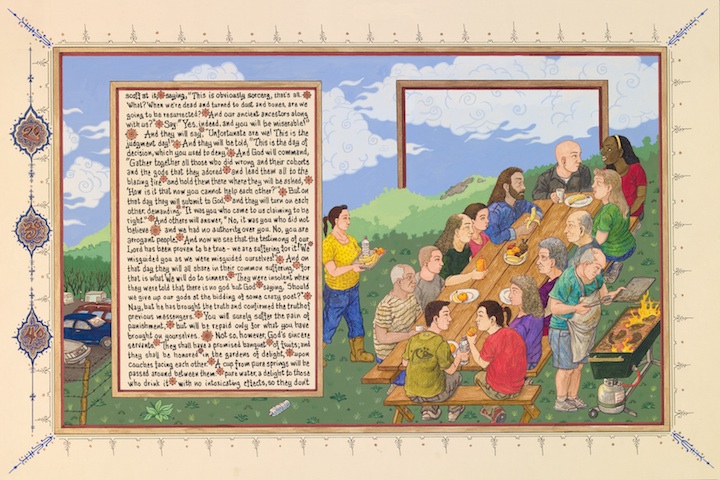
I’m not sure if any mujahedeen would be willing to die for that!
Doctored Text
Words matter. Allah declares in the Quran, “My word cannot be changed, nor am I unjust to My servants.” (Surah 50:28) So why have the words of the American Quran been changed to soften Allah’s harsh commands?
It is evident that Surah 4:34, which commands wife beating, “beat them” was changed to “restrain them.” Note in the image below that the text has been altered. Two lines are darker than the rest, and they do not line up with the rest of the text. Furthermore, if you check the 50 or so English translations of the Quran at www.islamawakened.org/quran/4/34 not a single translation uses the word “restrain.” However, the word “beat” is used in over half of the translations. Other translations use “strike” (5), “hit” (3), and “chastise” (3).
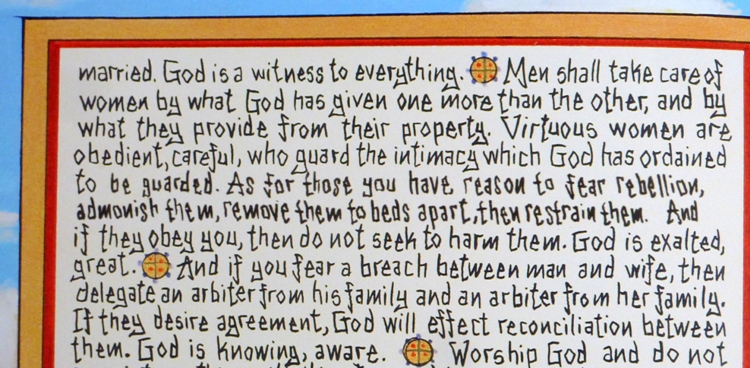
The other problem with the hand-written text is that there is no “spell-check” to catch inadvertent errors. Here is one error I spotted in the American Quran: In Surah 47:22, it says, “Ask [the unbelievers]: ‘Would you rather turn away from Him to spread disorder across the land and severe blood ties?’” The word should be “sever.”
Are Muslims just like other Americans?
The only Muslims depicted in the American Quran can be identified by their activities – praying on a city sidewalk and wearing a hijab while shopping. Birk wanted to create the impression that, generally, American Muslims look just like other Americans. This, of course, is not true. Islamic Sharia Law (See Reliance of the Traveller) stipulates that Muslim women must hide all but their hands and face from unrelated males (m2.8(1)), that it is unbelief (kufr) to imitate non-Muslims, believing their ways to be superior (e4.1(2)), and that, in a city, group prayers must be held in public places such that the manifestations of obedience to Allah’s command are evident. (f12.1)
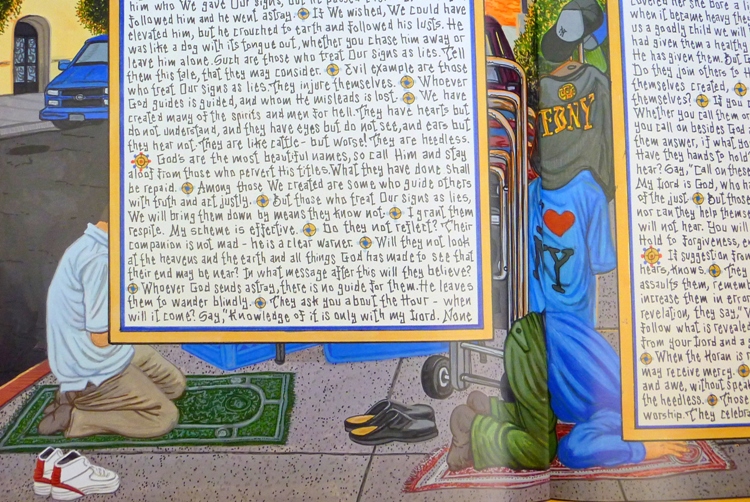
“Those who are near the Lord disdain not to do Him worship. They celebrate His praises, and prostrate before Him.” (Surah 7:206)
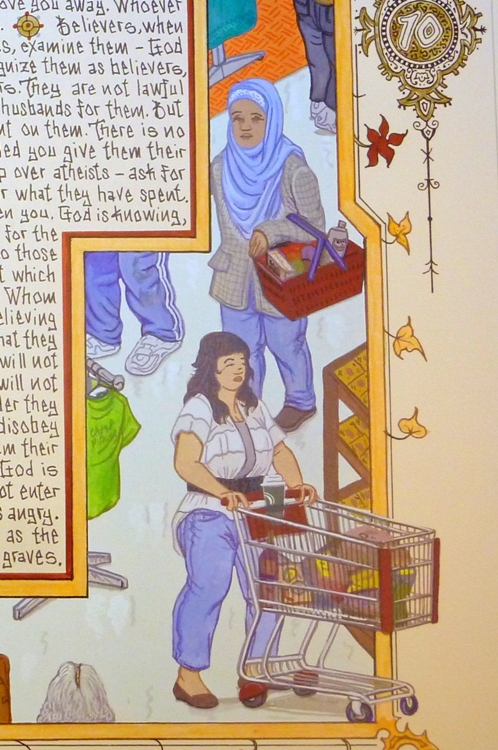
Believers, do not take My enemy and your enemy for friends. (Surah 60:1)
American Muslims are better assimilated and more productive than their counterparts in England, France, and Germany. Their most visible behavioral models, emanating from the Muslim Brotherhood and the sister organization, the Council on American-Islamic Relations (CAIR), promote strict adherence to Sharia Law. The chilling quote from Ibrahim Hooper, the co-founder of CAIR, says it all: “Islam isn’t in America to be equal to any other faith, but to become dominant. The Quran, the Muslim book of scripture, should be the highest authority in America, and Islam the only accepted religion on Earth.” While Muslims may deny this agenda, it is all too apparent in their activities and statements that they have vastly different values and practices than their fellow Americans.
Quranic vs. American Terrorism
The Quran contains numerous exhortations for Muslims to engage in jihad (fighting in the way of Allah) and terrorism. Despite efforts to scrub such words, some of these commands ended up in the text of the American Quran:
Surah 8:59: “Prepare what you can against them, including cavalry to strike terror into God’s enemy and yours and others whom you do not know but God knows.”
Surah 4:95: ‘Those who remain at home, except for the disabled, are not equal to those who struggle (mujahiduna) in the cause of God with their possessions and their lives.”
This Quranic terrorism, at the time of Muhammad, consisted primarily of raiding parties that captured caravans for booty and attacked settlements such as Khaybar. By 21st Century standards these acts of terrorism would be considered to be banditry and warmongering. However, the only evidence of Islamic terrorism is shown in the illustration at the beginning of this article – the attack on the World Trade Center in 2001. Instead, there are eight full-page illustrations of American military activities: Afghanistan (Surah 8), Guantanamo (Surah 8), Hiroshima (Surah 26), Iraq (Surah 27), Iraq (Surah 33), Iraq (Surah 47), Iraq (Surah 47), Iraq (Surah 105). Also, apparently to argue that terrorism is perpetuated by non-Muslims, there is a spread showing the 1995 Oklahoma City Bombing (Surah 28). Here is just one example of these tu quoque diversions:
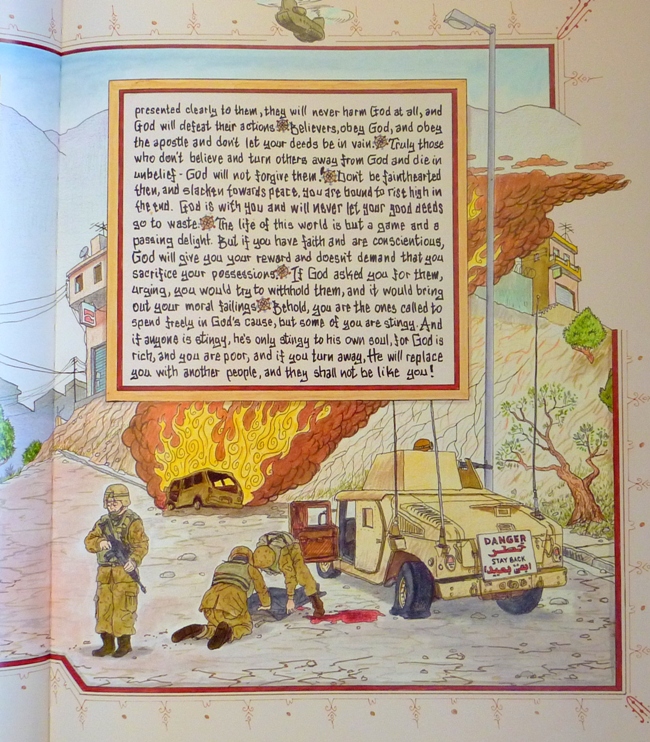
“How will [the unbelievers] fare when the angels gather them in death, striking their faces and their backs? (Surah 47:27)
A Religious or a Political Statement?
Early in the Quran project, Birk tried to get some Islamic scholars involved. None would respond. When asked about it, Usman Madha, the director of public relations at the King Fahad Mosque in Culver City, cautioned that many Muslims might find the project insulting to the Islamic faith. He said, “There is no such thing as an American Quran, or European Quran, or Asian Quran. If someone calls a work their own version of the Quran, they are misrepresenting the Quran as revealed to the prophet Muhammad by the angel Gabriel.” He also said, “If you look at Islamic history, we have never associated any revelations with imagery because then it becomes idol worship.” (None of BIrk’s images shows Muhammad, and only a few depict actual Muslims.)
According to Birk, “Given the global situation right now, the Quran may be the most important book on earth, but few Americans know anything about it. I’m attempting to create visual metaphors that go along with the text and hopefully make it more accessible to Americans, more relevant to American life.” There is irony to this goal, says Los Angeles Muslim journalist Tasbeeh Herwees: “Islam remains culturally relevant to the U.S. – not because it is welcomed here, but exactly because it is not. Consider this, and the very production of a Quran within a culture that wants to destroy it is rendered a political act.”
The reality is that the Quran is a diatribe against non-Muslims, women, and hypocrites beginning with the very first chapter. It is also a relentless incitement to wage war “for the cause of Allah” against non-Muslims. Rather than wanting to destroy the Quran, most Americans just want people to read it and visualize it for what it truly is – not a metaphor for the challenges of day-to-day American life.
Disclaimer: The articles published on this site represent the view of their writers.